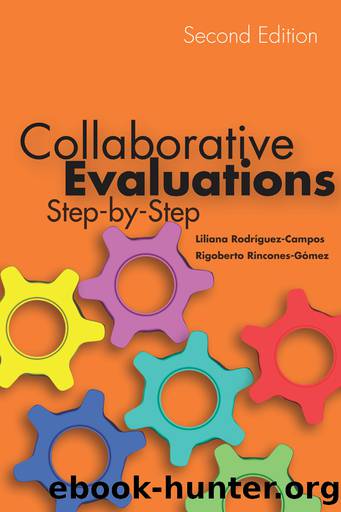Collaborative Evaluations by Rincones-Gómez Rigoberto;Rodríguez-Campos Liliana;Rincones-Gómez Rigoberto;

Author:Rincones-Gómez, Rigoberto;Rodríguez-Campos, Liliana;Rincones-Gómez, Rigoberto;
Language: eng
Format: epub
Publisher: Stanford University Press
Published: 2013-08-15T00:00:00+00:00
ENSURE ACTIVE PARTICIPATION
Active participation is when individuals (such as you and the CMs) take part and contribute with reciprocal input in the collaborative evaluation process to enhance it. You and the CMs may perceive the evaluation ârealityâ in a different way, due to the presence of multiple realities, and this requires the creation of an environment in which it is safe to take turns transmitting messages between one another in order to express your diverse opinions (such as ideas, uncertainties, and dissenting points).
Active participation is essential in a collaborative evaluation if everyone is to understand it. All the information to be used in an evaluation is normally considered to be very sensitive and should be treated with the highest confidentiality levels. As feasible, your responsibility is to make sure there is an open communication flow and an ongoing monitoring process of the collaborative effort. Socially skilled people work on the basis of the assumption that nothing important gets done alone (Goleman, 2004).
For the evaluation to be a true collaborative process, everyoneâs interests and opinions relevant to the evaluation efforts should be exchanged in a balanced way. The basics of democracy are that all those who have legitimate interests should be included in decisions that affect those interests (House & Howe, 2000). Make sure that there is a balance of power within the collaborative evaluation so that everyone feels represented in an appropriate and fair way (see Chapter 5 on how to encourage fairness and sincerity).
The CMsâ input is needed for diversity of opinions and to build support by listening to each individual. Make important decisions when every CM, as appropriate, has been heard and can agree to support a particular choice as the best course of action. A leader who automatically rejects othersâ opinions can be as unwise as one who unthinkingly goes along with them (Offermann, 2004).
Active participation allows you and the CMs to provide, react to, and prove new ideas generated within the evaluation. It builds the evaluation effort by avoiding the risk of biased interaction toward just the individuals who have their own specific agendas or interests. Deliberation should be based on the discussion of merits instead of the social status of participants (House & Howe, 2000). Therefore, foster a group dialogue of openness and exploration that continues among the CMs themselves (even outside formal meetings), in which everyone uses the ideas raised in order to obtain sincere reactions.
Encourage every CM to interact in the ongoing evaluation efforts. Each meeting is an opportunity to exchange ideas and to observe and acknowledge everyoneâs own needs. The goal is that you and every CM are able to provide ideas or express any concern as feasible. Besides meetings, there are other means to encourage active participation in ways that are useful for the purposes of the collaborative evaluation. For example, you may use emailing, blogging, and tweeting.
You and the CMs must understand how the information you send and receive (for example, in sessions or meetings) will affect the collaborative evaluation effort as a whole.
Download
This site does not store any files on its server. We only index and link to content provided by other sites. Please contact the content providers to delete copyright contents if any and email us, we'll remove relevant links or contents immediately.
Hit Refresh by Satya Nadella(9040)
The Compound Effect by Darren Hardy(8813)
Change Your Questions, Change Your Life by Marilee Adams(7637)
Nudge - Improving Decisions about Health, Wealth, and Happiness by Thaler Sunstein(7622)
The Black Swan by Nassim Nicholas Taleb(7016)
Deep Work by Cal Newport(6885)
Daring Greatly by Brene Brown(6449)
Rich Dad Poor Dad by Robert T. Kiyosaki(6413)
Principles: Life and Work by Ray Dalio(6220)
Playing to Win_ How Strategy Really Works by A.G. Lafley & Roger L. Martin(5930)
Man-made Catastrophes and Risk Information Concealment by Dmitry Chernov & Didier Sornette(5924)
Digital Minimalism by Cal Newport;(5667)
Big Magic: Creative Living Beyond Fear by Elizabeth Gilbert(5615)
The Myth of the Strong Leader by Archie Brown(5427)
The Slight Edge by Jeff Olson(5352)
Discipline Equals Freedom by Jocko Willink(5286)
The Motivation Myth by Jeff Haden(5157)
Stone's Rules by Roger Stone(5027)
The Laws of Human Nature by Robert Greene(5001)
